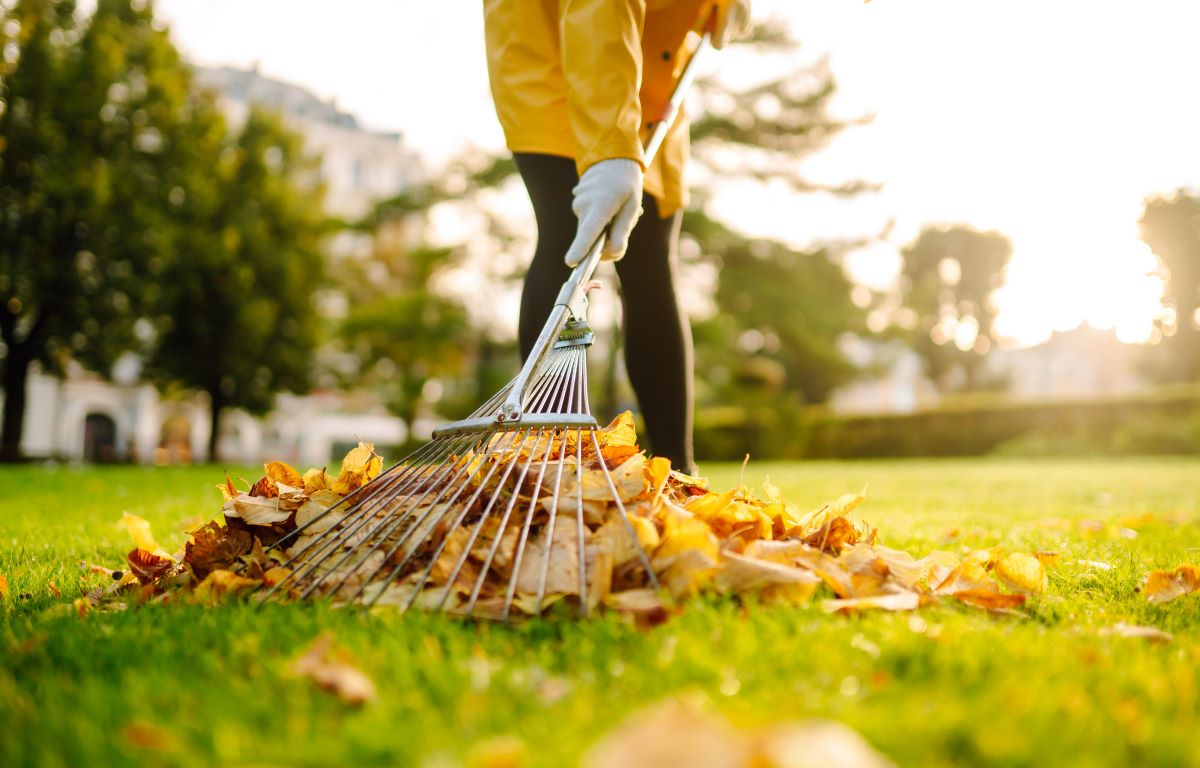October’s here, and while the temperature’s dropping, your garden still needs a bit of love before it’s ready for winter. It’s easy to think that autumn means you can pack away the tools and wait for spring, but trust me, putting in the effort now will make things so much easier next year. Let’s walk through some key tasks to help you get your garden in tip-top shape, so it’s ready to face the winter and bloom beautifully in the spring.
Here are some tips on what you need to tackle in your garden this October.
Clearing the Fallen Leaves
By now, your garden is probably covered in leaves, and while they look lovely, they can cause trouble if left too long. Wet leaves can smother your grass and encourage pests and diseases. Plus, they’re a bit of a slip hazard if you’ve got paths or patios. Get yourself a good rake or leaf blower, and start clearing them away.
But don’t just bin them! Fallen leaves are brilliant for making leaf mould. Pop them into black bin bags, poke a few holes in the bags for air, and leave them somewhere out of the way. Come spring, you’ll have some fantastic compost that’ll do wonders for your soil.
Last Mow Before Winter
October’s probably your last chance to give the lawn a good cut before winter kicks in. Set your mower blades a bit higher than usual—don’t scalp the grass, or it’ll struggle in the cold. This will tidy it up and leave it looking neat as we head into the colder months.
And while you’re at it, it’s a good idea to aerate your lawn too. If your grass has seen a lot of foot traffic over the summer, it’ll be compacted. Grab a garden fork and poke some holes around the lawn—this helps water and nutrients reach the roots, giving your grass a fighting chance through the winter.
Pruning Trees and Shrubs
Now’s the time to give some of your trees and shrubs a trim. Any branches that are dead, diseased, or damaged should come off. It’s also a good idea to thin out overcrowded branches to improve air circulation, which will help prevent fungal diseases.
But be careful not to get too scissor-happy! Some spring-flowering shrubs, like forsythia or magnolia, shouldn’t be pruned now because you’ll be cutting off next year’s blooms. Save those for a tidy-up after they’ve flowered in the spring.
Plant Spring Bulbs
It might seem a bit mad to think about spring when it’s getting colder, but planting bulbs in October will give you a lovely display come March. Now’s the perfect time to plant daffodils, tulips, crocuses, and hyacinths.
Pick a sunny spot with well-drained soil, and get those bulbs in the ground. A good rule is to plant them at a depth that’s about three times the height of the bulb. If you fancy a more natural look, scatter them around randomly rather than planting in straight rows—this can give a more relaxed, cottage-garden feel.
Divide Your Perennials
If you’ve got any clumps of perennials (like hostas or asters) that have grown a bit too big, October’s a great time to divide them. Dig up the whole clump, shake off the soil, and use a sharp spade to divide the plant into smaller sections. Each section should have plenty of roots attached so it can grow back strong.
Replant these divisions, water them in well, and you’ll have even more plants for next year. Dividing perennials not only keeps them healthy, but it also means you can fill in gaps in your borders—or give a few away to neighbours if you’ve got more than you need.
Want Some Help With Your Garden?
Harvesting and Storing Veg
If you’ve been growing veg this year, October is when you’ll be picking the last of your late-season crops. Carrots, parsnips, and beetroot can all be lifted now, along with any kale or spinach. Make sure you pull up any potatoes before the first frost hits too, as the cold can damage them.
Don’t forget to check on your pumpkins and squashes. They should be ready to harvest once their skins are hard, and they sound hollow when tapped. Cut them from the vine, leave a bit of stem attached, and store them in a cool, dry spot—they’ll last for ages.
Tidying the Greenhouse
If you’ve got a greenhouse, now’s the time to give it a good clean before winter. Wash the glass to let in as much light as possible and clean up any old pots, dead plants, or debris that might be hanging around. A clean greenhouse will help stop pests and diseases from taking hold over the winter.
You might also want to think about adding some insulation, like bubble wrap, to keep things warmer in there during the colder months. If you’re planning on growing winter crops, like salad greens, check that your heating system is working, and get ready to protect any plants from frost.
Mulching and Feeding
Mulching is one of the best things you can do for your garden in October. A thick layer of mulch—like compost, well-rotted manure, or leaf mould—around the base of your trees, shrubs, and perennials will help keep the soil warm, lock in moisture, and suppress weeds.
Autumn is also a good time to feed your plants, especially those that’ll be going dormant for the winter. Use a slow-release fertiliser to give them the nutrients they need to stay healthy through the cold months, so they’re ready to bounce back in spring.
Protecting Tender Plants
Some plants aren’t cut out for the cold, so you’ll need to protect them. If you’ve got dahlias, cannas, or pelargoniums, you’ll want to either dig them up and store them indoors or cover them with horticultural fleece, straw, or cloches to keep them warm.
For tender plants you can’t move, add a thick layer of mulch around the base to help protect their roots. If you’ve got potted plants, it’s a good idea to bring them inside or into a greenhouse, if possible, to keep them safe from frost.
Planning for Next Year
Now’s a good time to reflect on how your garden has done this year and start planning for next. What worked well? What didn’t? Maybe you’d like to add some new plants, expand your veg patch, or try something different with your borders.
Autumn is the perfect time to order seeds and bulbs, sketch out new planting schemes, and think about how you’d like your garden to look next spring. It’s also a good idea to clean and sharpen your tools, so they’re ready for the busy growing season ahead.
Check Your Fences and Sheds
Autumn winds can do a number on fences, sheds, and garden furniture, so take the time now to give them a once-over. Check for any loose panels, missing screws, or general wear and tear. If anything needs fixing or treating with wood preservative, October’s a good time to get it done before the winter weather sets in.
Keep an Eye on Wildlife
As the weather cools, many animals will be looking for places to hibernate or shelter. If you’ve got a pile of logs or a corner of your garden that’s a bit wild, consider leaving it as a haven for wildlife. Hedgehogs, frogs, and insects will appreciate it.
If you’ve got bird feeders, make sure they’re cleaned and filled regularly, as birds will rely more on supplementary food as natural sources start to dwindle.
Final Thoughts
October might feel like a winding-down period in the garden, but there’s still plenty to do. By staying on top of these tasks—clearing leaves, planting bulbs, and protecting tender plants—you’ll give your garden the best chance to thrive over winter and come back strong in the spring.
So, grab your gloves, get outside, and enjoy the fresh autumn air. Your garden will thank you for it!
Our Most Popular Gardener Searches
Gardeners in Stoke on Trent
Gardeners in Southampton
Gardeners in Derby
Gardeners in Swansea
Gardeners in Liverpool
Gardeners in Edinburgh






13 Comments
nejlevnější kamagra online koupit
kde můžete získat kamagra bez perskripionu
itraconazole without prescription cheap
buy cheap itraconazole buy germany
cheap fildena generic prices
fildena without a perscription or membership
purchase gabapentin generic brand
discount gabapentin generic name
buying dutasteride cheap from usa
purchase dutasteride purchase online uk
Buy flexeril cyclobenzaprine on line without a perscription
ordering flexeril cyclobenzaprine purchase line
medicament kamagra pilule du lendemain
kamagra sans ordonnance mexique
buy avodart generic overnight delivery
ordering avodart generic mexico
how to order staxyn generic dosage
purchase staxyn canada over the counter
Buy xifaxan without a perscription to ship overnight
discount xifaxan cheap with prescription
buying rifaximin generic uae
get rifaximin generic order
ordering enclomiphene australia discount
online order enclomiphene buy dallas
buying androxal generic usa
androxal no prescription cod